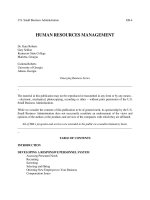human resources management _ section 1-basics of hrm
Bạn đang xem bản rút gọn của tài liệu. Xem và tải ngay bản đầy đủ của tài liệu tại đây (1.28 MB, 28 trang )
Human Resource
Management
ESSENTIAL PERSPECTIVES
© 2005 Southwestern College Publishing. All rights reserved.
Basics of Human Resource
Management
Section 1
Robert L. Mathis John H. Jackson
PowerPoint Presentation
by TRUONG THI LAN ANH
© 2005 Southwestern College Publishing. All rights reserved. Truong T. Lan Anh 1–2
Learning Objectives
After you study this section, you should be able to:
– Define HR management and explain why managers and
HR staff must work together.
– List and define the seven categories of of HR activities.
– Identify three challenges facing HR today.
– Discuss why human resources can be a core
competency for organizations.
– Describe the four roles of HR management.
– Discuss why ethical issues affect HR management.
– Consider HRM as a career field.
© 2005 Southwestern College Publishing. All rights reserved. Truong T. Lan Anh 1–3
Nature of Human Resource Management
Human Resource Management
– The design of formal systems in an organization to
ensure effective and efficient use of human talent to
accomplish organizational goals.
Who Is an HR Manager?
– In the course carrying out their duties, every operating
manager is, in essence, an HR manager.
– HR specialists design processes and systems that
operating managers help implement.
– However, in the practice, the position of HR
Manager/Director is reserved for a HR specialist in
organization.
© 2005 Southwestern College Publishing. All rights reserved. Truong T. Lan Anh 1–4
Cooperation of HR with Operating Managers
HR Unit
– Develops legal, effective
interviewing techniques
– Trains managers in
conducting selection
interviews
– Conducts interviews and
testing
– Sends top three applicants
to managers for final review
– Checks references
– Does final interviewing and
hiring for certain job
classifications
Managers
– Advise HR of job openings
– Decide whether to do own
final interviewing
– Receive interview training
from HR unit
– Do final interviewing and
hiring where appropriate
– Review reference
information
– Provide feedback to HR
unit on hiring/rejection
decisions
© 2005 Southwestern College Publishing. All rights reserved. Truong T. Lan Anh 1–5
HR Activities
1. HR Planning and Analysis
2. Equal Employment Opportunity
3. Staffing (Recruiting and Selecting)
4. HR Development
5. Compensation and Benefits
6. Health, Safety, and Security
7. Employee and Labor/Management Relations
© 2005 Southwestern College Publishing. All rights reserved. Truong T. Lan Anh 1–6
HR
Management
Activities
Source: HR Department Benchmarks and Analysis Survey 2004
(Washington, DC: Bureau of National Affairs, 2004), 21. To purchase
this publication and find out more about other BNA HR solutions visit
or call 800-372-1033. Used with permission.
Figure 1–1
© 2005 Southwestern College Publishing. All rights reserved. Truong T. Lan Anh 1–7
Smaller Organizations and HR Management
Compliance with
Government
Regulations
Shortage of
Qualified
Workers
Increasing
Costs of
Benefits
Rising Taxes
Issues of
Greatest
Concern
© 2005 Southwestern College Publishing. All rights reserved. Truong T. Lan Anh 1–8
HR Management Challenges
Globalization of Business
– Outsourcing and increased competition
– The threat of terrorism
Economic and Technological Changes
– Occupational shifts from manufacturing and
agriculture to service industries and
telecommunications.
– Pressures of global competition causing firms to
adapt by lowering costs and increasing productivity.
Technological Shifts and the Internet
– Growth of information technology.
© 2005 Southwestern College Publishing. All rights reserved. Truong T. Lan Anh 1–9
HR Management Challenges
Workforce Availability and Quality
– Inadequate supply of workers with needed skills for
“knowledge jobs”
– Education of workers in basic skills
Growth in Contingent Workforce
– Increases in temporary workers, independent
contractors, leased employees, and part-timers
caused by:
• Need for flexibility in staffing levels
• Increased difficulty in firing regular employees.
• Reduced legal liability from contract employees
© 2005 Southwestern College Publishing. All rights reserved. Truong T. Lan Anh 1–10
HR Management Challenges
Demographics and Diversity Issues
– More diversity of nationalities, hometown origin (the city
or distant provinces), gender, age, and ethnicity
– Other diversity: educational background, etc.
More diversity, more discrimination
More Women in the Workforce
– Dual-career couples
– Single-parent households
– Working mothers and family/childcare
© 2005 Southwestern College Publishing. All rights reserved. Truong T. Lan Anh 1–11
HR Management Challenges
Organizational Cost Pressures and Restructuring
– Mergers and Acquisitions (M&A)
– “Right-sizing” - eliminating of layers of management,
closing facilities, merging with other organizations, and
outplacing workers
• Intended results are flatter organizations, increases in
productivity, quality, service and lower costs.
• Costs are “survivor mentality”, loss of employee loyalty,
and turnover of valuable employees.
– HR managers must work toward ensuring cultural
compatibility in mergers.
© 2005 Southwestern College Publishing. All rights reserved. Truong T. Lan Anh 1–12
Human Resources as a Core Competency
Strategic Human Resources Management
– Organizational use of employees to gain or keep a
competitive advantage against competitors.
Core Competency
– A unique capability in the organization that creates
high value and that differentiates the organization
from its competition.
© 2005 Southwestern College Publishing. All rights reserved. Truong T. Lan Anh 1–13
Possible HR Areas for Core Competencies
Figure 2–1
© 2005 Southwestern College Publishing. All rights reserved. Truong T. Lan Anh 1–14
HR-Based Core Competencies
Organizational Culture
– The shared values and beliefs of the workforce
Productivity
– A measure of the quantity and quality of work
done, considering the cost of the resources used.
– A ratio of the inputs and outputs that indicates the
value added
by an organization.
Quality Products and Services
– High quality products and services are the results of
HR-enhancements to organizational performance.
© 2005 Southwestern College Publishing. All rights reserved. Truong T. Lan Anh 1–15
Different Roles for HR Management
Figure 1–5
© 2005 Southwestern College Publishing. All rights reserved. Truong T. Lan Anh 1–16
Strategic Role for HR
Strategic Role
– “Contributing at the Table” to organizational results
– HR becomes a strategic business partner by:
• Focusing on developing HR programs that enhance
organizational performance.
• Involving HR in strategic planning at the onset.
• Participating in decision making on mergers, acquisitions,
and downsizing.
• Redesigning organizations and work processes
• Accounting and documenting the financial results of HR
activities.
© 2005 Southwestern College Publishing. All rights reserved. Truong T. Lan Anh 1–17
HR Management Roles
Administrative Role
– Clerical and administrative support operations (e.g.,
payroll and benefits work)
Employee Advocate Role
– “Champion” for employee concerns
• Employee crisis management
• Responding to employee complaints
Operational Role
– Identification and implementation of HR programs
and policies—EEO, hiring, training, and other
activities that support the organization.
© 2005 Southwestern College Publishing. All rights reserved. Truong T. Lan Anh 1–18
How HR Spends Its Time
Figure 1–6
Source: Adapted from “How Much Time Should Your HR staff Spend on Recruiting?”
Human Resources Department Management Report, June 2000, p. 6.
© 2005 Southwestern College Publishing. All rights reserved. Truong T. Lan Anh 1–19
Overview of HR Management Roles
Figure 1–7
© 2005 Southwestern College Publishing. All rights reserved. Truong T. Lan Anh 1–20
Changing Roles of HR Management
Figure 1–5
Note: Example percentages are based on various surveys.
© 2005 Southwestern College Publishing. All rights reserved. Truong T. Lan Anh 1–21
New Approaches to HR Management
Collaborative HR
– The process of HR professionals from several
different organizations working jointly to address
shared business problems.
• Firms benefit from the expertise of other firms, without
having the time and expense of developing some of
their own HR practices.
© 2005 Southwestern College Publishing. All rights reserved. Truong T. Lan Anh 1–22
HR Technology
Human Resource Management System
(HRMS)
– An integrated system providing information used by
HR management in decision making.
– Purposes (Benefits) of HRMS
• Administrative and operational efficiency in compiling
HR data
• Availability of data for effective HR strategic planning
– Uses of HRMS
• Automation of payroll and benefit activities
• EEO/affirmative action tracking
• HR Workflow: increased access to HR information
© 2005 Southwestern College Publishing. All rights reserved. Truong T. Lan Anh 1–23
Ethics and HR
What is Ethical Behavior?
– What “ought” to be done Code of ethics
– Dimensions of decisions about ethical issues in
management:
• Extended consequences
• Multiple alternatives
• Mixed outcomes
• Uncertain consequences
• Personal effects
© 2005 Southwestern College Publishing. All rights reserved. Truong T. Lan Anh
Examples of Ethical Misconduct in HR Activities
© 2005 Southwestern College Publishing. All rights reserved. Truong T. Lan Anh 1–25
Ethical Issues in Management
Most Common Forms of Unethical Conduct
– Lying to supervisors
– Employee drug use or alcohol abuse, cigarette use in
the workplace
– Falsification of records
International Ethical Issues
– Gift giving and bribery (corruption)
– Discrimination in hiring and treatment
Addressing Ethical Issues
– Code of ethics
– Training managers and employees









